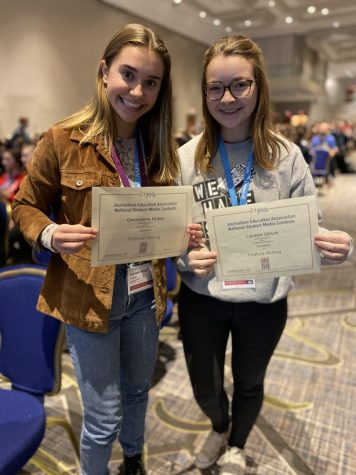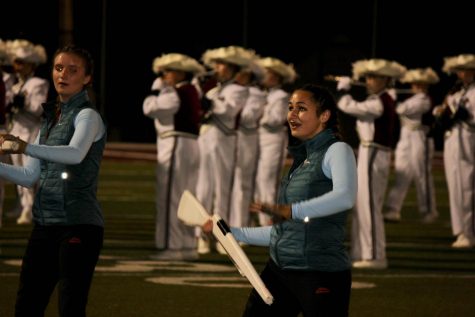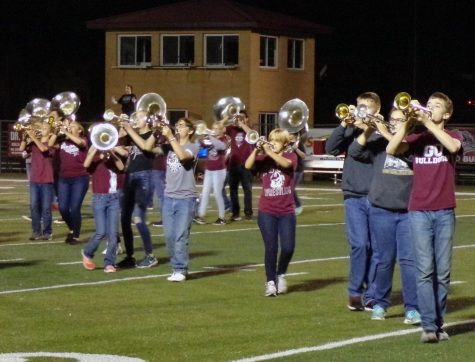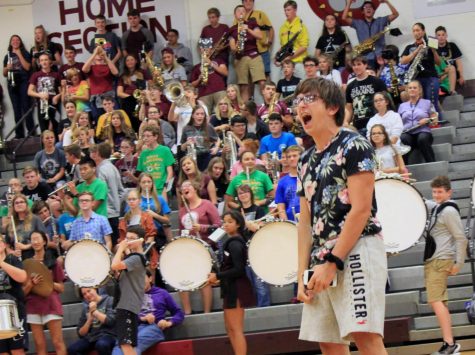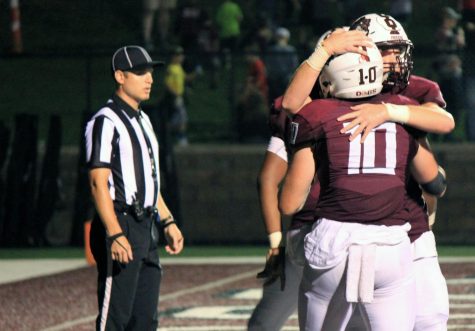Historic solar eclipse puts central Missouri in totality

Millions of people flew from far and wide to attend the first eclipse in the United States since 1918. Those lucky enough to score viewing glasses before they sold out clutched them excitedly as the sun was barely in the sky at 8 o’clock in the morning. The air may have been humid and hot, but it was buzzing with energy from crowds of interested families queuing at every booth. The eclipse viewing festival in Jefferson City was arguably the place to be for the full experience.
Chris Hartenstine is a fairly short, athletic looking middle aged man filled with the energy of a child. He speaks so fast you can hardly keep up, and his hand gestures are frantic as he explains his presentation about the eclipse. He stands in the shade of a NASA booth, yet is soaked in sweat, probably because his speaking is so energetic that it becomes a sport. Despite his high intensity, his teaching is precise and well spoken. He teaches anyone that will listen a short, but jampacked with information lesson on the eclipse and common misconceptions.
“A lot of people think that the Moon is reasonably 60 – 70% of the Earth. The thing is that that’s not the truth. The truth is, in this scale with the Earth only about 10 or 11 inches in diameter, the Moon is about two and a half inches. On this scale, the Moon has to go 20 feet away. In actual reality, if you wanted to do this scale better, the sun would need to be 91 feet in diameter and be 2 miles away. That’s the actual distance of our solar system,” Hartenstine said.
With this new information in mind, Hartenstine continues without skipping a beat to explain that he was in Missouri at the festival to demonstrate to people what exactly the eclipse is and what they are seeing. Sweat beads off of his balding head as time until the eclipse ticks on to 9 o’clock. He ignores a phone call,but lets it ring as if he doesn’t notice. His eyes light up when speaking about his job at NASA and he slows his speaking as if he really needs you to get every word.
“I’m an education coordinator at NASA Glenn Research Center. When you talk about NASA science you talk about the aeronautics and the space and it’s verycomplicated high-level stuff. A lot of times we’re talking about to the general public who are not necessarily comfortable with science, or we’re talking to kids. I talk to the scientists and engineers and the experts and they tell me what they do. I work with them to to bring it down to a level that’s consumable for the general public,” Hartenstine said.
Hartenstine seems like he knows absolutely everything there is to know about science and math. He speaks with no hesitation and purely expresses his knowledge. It’s hard to believe his career at NASA wasn’t his first. Hartenstine was always interested in math and science, and taught it at the middle school level for about 5 years before spotting a classified ad in the newspaper. Miraculously, he fit NASA’s needs perfectly, but still he doubted himself.
“I was like ‘Oh there’s no way they want me. I’m a young teacher; I don’t have any major credentials; I don’t have any accomplishments’. My wife said ‘If you do not apply you will regret it for the rest of your life. So I overnight ship the application. They called me a week later, and two weeks later I was doing this kind of stuff,” Hartenstine said.
With his dreams coming true, Hartenstine has been able to travel the country teaching what he loves. He used his story of an ordinary job application to inspire greatness in others. His smile brightened as a larger crowd gathered to hear his uplifting spirit.
“So when you feel like ‘Oh my gosh, NASA nobody wants me there, I’m not good enough. That is not the case. You are good enough, you just have to build up the confidence level for it.
It’s a wonderful opportunity and I’ve been taking advantage of it. I’ve been able to do magical events like this,” Hartenstine said.
Though Hartenstine has been with NASA for a decade, he speaks highly of the corporation. As time ticks closer and closer to the eclipse starting, he seems to speed up his speech.
“It’s really amazing. Every step along the way you’re thinking this is the coolest strangest thing I’ve ever done and then they say, ‘I need you to get on a plane and go to the middle of Missouri and do a demonstration that proves how the eclipse works’,” Hartenstine said.
A large crowd had gathered around the small NASA booth. No one spoke so they could catch every word Hartenstine said. Taking his opportunity to inform a larger crowd, he began to explain what many were unaware of.
“Everyone you see from NASA here is from Glenn Research Center in Cleveland, Ohio. People don’t realize, but there’s actually 10 centers. We are the only one in the Midwest and we take full advantage of that. The cool thing about Glenn is that we are a research center, so we get to see the advancements and test them 5 to 10 years before they ever make it onto space for our next mission,” Hartenstine said.
It was 10 o’clock and the sun was beating down on the crowded capital. Food trucks serving warm funnel cakes or popcorn provided little relief. More and more people piled onto open areas and several lounged in chairs or on blankets. The line waiting for the NASA exhibit trailed long past another booth and parents fanned themselves lazily as they waited.
Another NASA employee sat in the shade of the second booth with several small gadgets laid out. Children gathered to tinker and play with them while she explained the science and math behind each contraption. Kristin Spear wore sunglasses that covered most of her freckled face. The exact opposite of Hartenstine, she spoke slowly and chose her words carefully before speaking. Her hands stayed on the table and she patiently explained the answer to every question a child interrupted her with. She spread her arms, gesturing to the plastic toys on the table.
“These are energy conversion demonstrations. We are showing how energy is not created or destroyed, it only changes from one form to another. It shows how we can harness that energy then to power spacecrafts,” Spear said.
Spear looked forward and up while she thought. Her eyebrows furrowed under large sunglasses as she chose her words.
“My job title is communication specialist at NASA Glenn Research Center. This is part of what I do. I get to come and talk to people about what radioisotopes are program and how we enable Nasa to explore regions that we were unable to explore previously,” Spear said
Spear nods her head slowly as she speaks. She is often cut off and proceeds to teach a kid how to make the fan spin counterclockwise. Patiently, she asks questions like a teacher in class and encourages them to experiment with new things. When there is a break in the flow of questions she continues her story.
“I work with the radioisotope system program. This provides power for deep space missions or anywhere where solar is not a viable option, and that’s why we are here today,” Spear said.
NASA seems like a corporation much too busy to attend a festival in the capital of Missouri, but it was actually the perfect spot for the Glenn Research Center. Spear spoke with certainty and peered over her sunglasses.
“Jefferson City is within the line of totality and it’s also within Glenn’s region of support and probably the closest Center to Missouri. Cleveland itself is not within the line of totality so we try to come to regions that aren’t usually supported by other methods, so that everybody in the country gets a chance to have the experience that NASA provides,” Spear said
Spear, unlike Hartenstine, was on a very different route when in school.
“I was actually an art major in college. Graphic design and computer art. My job at NASA got me into it. However, when I was in the sixth grade I was very interested in space. They asked me what I wanted to do and I said ‘Something with either space or art’ so now I get to do both,” Spear said.
Acquiring a job at NASA seems like something only a select few people are capable of. Coincidentally enough, both Hartenstine and Spear stumbled upon an ad in the newspaper and took a shot in the dark. Their success stories were a memorable part of the festival for many people among the crowds.
At 10:30 the sun was still whole and everyone could feel it. People started testing out their viewing glasses and grabbing an early lunch. The crowd grew and Missouri State Parks employees aided anyone needing to buy glasses or get information on any aspect of the affair. Connie Patterson wore her Missouri State Parks shirt and smiled kindly at anyone that passed her as she stood alert in the shade of a booth. She spoke with grace and great pride and folded and unfolded her hands. Her pale face was red from the sun and her blonde hair turned a shade darker from sweat. She took in a deep breath before she spoke.
“Missouri Department of Natural Resources, through its division of state parks, played a tremendous role in helping this thing come together today. As you can see, our state parks are here and we have several booths and exhibits and lots of fun out for folks today to come talk to us to have fun at the Capitol during the eclipse,” Patterson said.
The festival was expecting about 50 thousand people from all across the state and country to attend the viewing at the capital, and that took over a year of planning to bring together. Purely by coincidence, the state park’s 100th anniversary was also on that day, and every employee celebrated their hard work as well as the anniversary with pride and happiness.
With the capitol building as the backdrop, food trucks lined the closed off roads and booths crowded the lawn. Organizations signs were visible from most angles and their lines weaved around each other.
Finally, it was time for the eclipse to start. People crowded into the street for a better view. Only a small C shape was taken out of the sun at that point. Chairs, blankets, and umbrellas covered the grass and strangers stopped everything to stare upward at the disappearing sun. An hour passed and every 5 minutes it seemed that thousands of people were stopping to check the progress of the eclipse. The blazing heat was not getting any better and, although it was being covered, the sun was not backing down.
The last 10 minutes, the world darkened and the energy in the air was excited as everyone looked up, no one paying attention to anything but the sun and the moon. Air horns blew when the last speck of sun disappeared and the crowd hurriedly took their glasses off. Thousands of people ooh’d and ahh’d at the sight of the sun completely gone, just the corona shining brightly. Crickets chirped and people yelled out, but no one was paying attention to anyone else.
Before anyone knew it, the air horns blew again and the crowd looked immediately down to put the glasses back on. The sun returned just as quick as it had left and it was all over. In disbelief, Hartentine’s enthusiastic tone rang true.
“This whole mess of people are going to bond together on something that brings us from all types of different places and I absolutely love that. I hope you all enjoy taking in the moment because it’s only going to be two and a half minutes of wonder,” Hartenstine said.
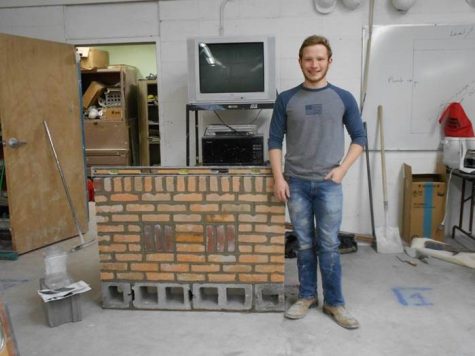
Those playing tennis at the courts in town have probably noticed the pavilion being built over the past year. However, most students have not realized...



